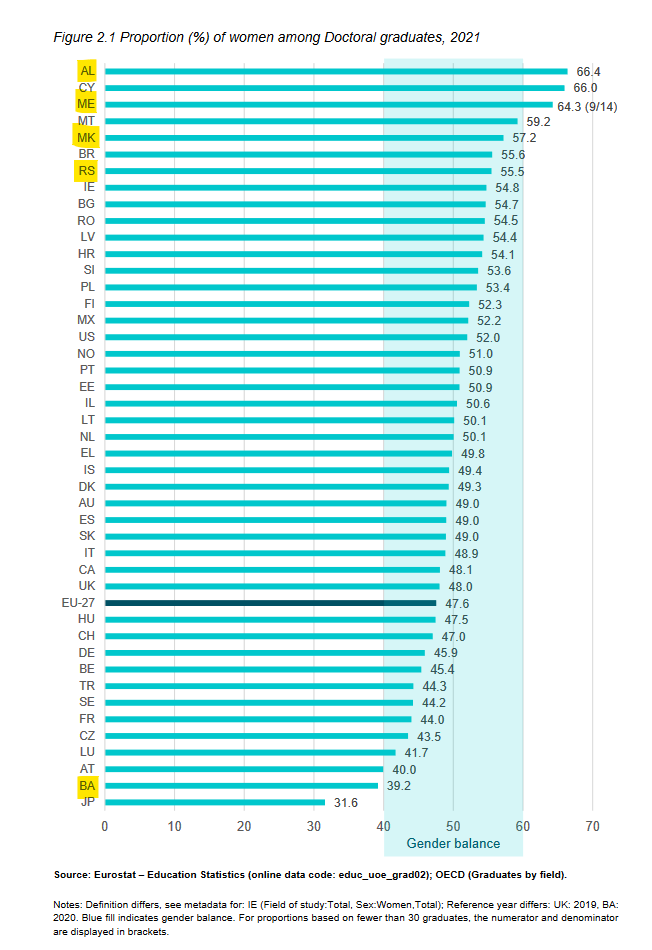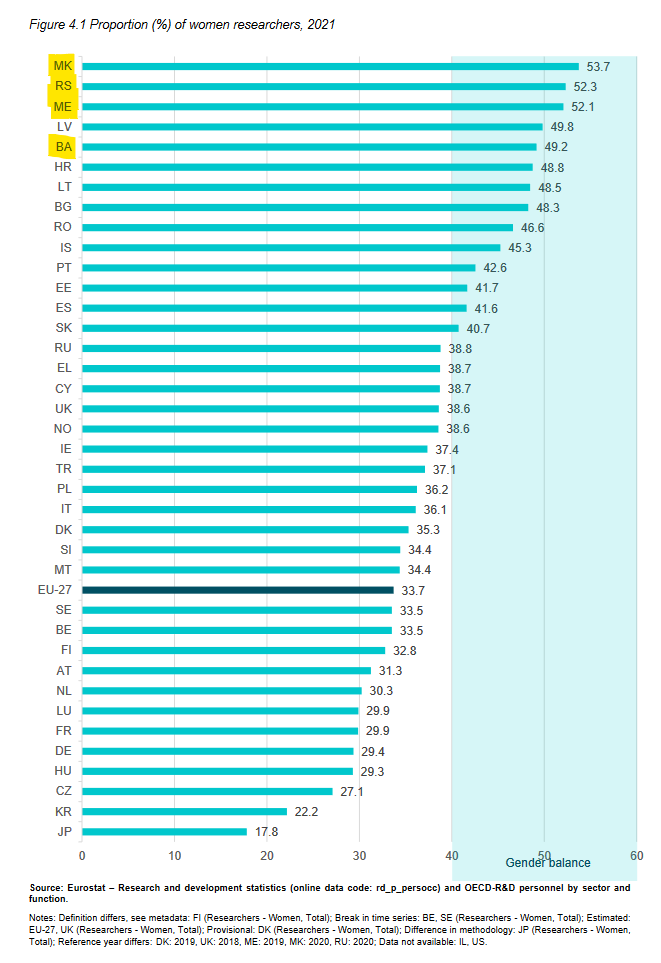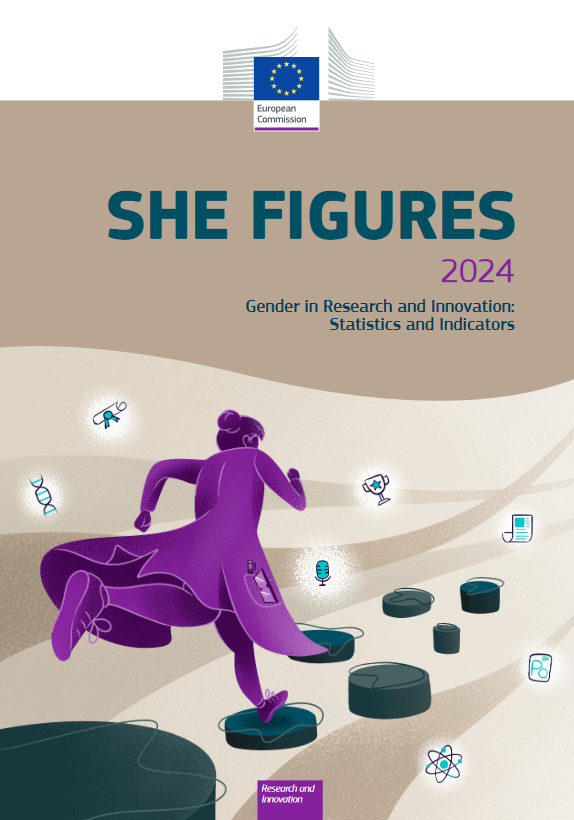The the latest edition of the European Commission’s flagship publication series, She Figures, presents the most up-to-date and Europe-wide statistics on gender equality in Research and Innovation (R&I). Since 2003, the She Figures publication has been instrumental in tracking progress towards gender equality in R&I, offering a unique and reliable source of gender-disaggregated data and analysis. Drawing on comprehensive datasets from the EU, countries associated with Horizon Europe, and the G20, it is an indispensable resource to advance gender equality and promote inclusive innovation.
Geographical coverage
Unless otherwise specified, the data collection for She Figures 2024 covers 44 countries, namely the 27 European Member States (EU-27), the United Kingdom (UK) and the countries associated to Horizon Europe: Iceland, Norway, Bosnia and Herzegovina, Montenegro, Moldova, North Macedonia, Albania, Serbia, Türkiye, Ukraine, Kosovo, Georgia, Armenia, Faroe Islands, Israel and Tunisia. Where readily available, data are also compiled for the G20 region: Argentina, Australia, Brazil, Canada, China except Hong Kong, Hong
Kong, India, Japan, Mexico, Russia, South Africa, South Korea and the United States (US).
The indicators present the latest data available for a given data source during the production of this report, which is 2021 or 2022 for most indicators (with the specific reference year(s) provided in the title of each indicator).
Results in brief
Overall, women outnumber men in university education, they remain strikingly underrepresented in Science, Technology, Engineering, and Mathematics (STEM) careers and leadership. The report reveals a widening gender gap in critical sectors like ICT, where only 22% of doctoral graduates are women. This not only deepens the EU’s existing skills shortages but also threatens long-term competitiveness. Gender disparities persist at the highest levels of research and innovation, with just 9% of inventors being women and 98% of EU research failing to integrate a gender dimension.
The report
In line with previous editions, She Figures 2024 follows the chronological journey of researchers from higher education into the labour market and on to decision-making and leadership positions. The report supports evidence-based policymaking and promotes gender mainstreaming across R&I policies at both national and EU levels. A significant addition for 2024 is the introduction of the pilot She Figures Index: a composite indicator measuring Member States’ progress towards gender equality in R&I. It offers a comparative perspective on gender equality efforts and enhances the She Figures contribution to fostering a more inclusive European R&I landscape. The main report is accompanied by four policy articles on emerging and ongoing policy priorities, and 27 country fiche offering valuable context to the data.
Results for the Western Balkans
Particularly high in the Western Balkans (except for Bosnia and Herzegovina) is the proportion of women among doctoral graduates (data from 2021, report page 44 and following). In fact, Albania is the country with the highest percentage of all measured with 66.4 %. Bosnia and Herzegovina achieved gender balance in 2019 (42 %), but the proportion of women Doctoral graduates declined to 39 % in 2020.

The report (page 138) also shows the high percentage of women researchers in the Western Balkans where North Macedonia is top on the league table.

High percentages are also reported for the business sector.
The report (page 54 and following) also highlights several good practices from the region
Actions to improve women’s representation in ICT and Engineering in Associated Countries
In Bosnia and Herzegovina, the Bosnian Women Scientists’ Research Opus Conference highlights the contribution of women to the development of science and their current position in academia and society. The conference centres on advocating for more to be done to attract, promote, and retain women within all scientific fields. Following the 2018 conference, 51 papers were published as part of the proceedings.
Also in Bosnia and Herzegovina, the IT Girls initiative, implemented by the United Nations (UN), has supported more than 2 000 girls and women in IT. An event in April 2023 to raised awareness of the initiative, celebrated girls in IT, and highlighted good practices and remaining challenges.
In North Macedonia, the Global Engineer Girls (GEG) North Macedonia programme supports women students in engineering at six universities. It provides scholarships,mentorship, and online training programmes for developing soft skills and internship opportunities. Another initiative is the STEM education and career – a challenge for girls and young women (WomenInStem) project, which promotes STEM careers by successful women in this field. The project conducted research on the main barriers to career development in STEM faced by women and provided recommendations based on its findings.
Similar on page 158:
Supporting women within science & technology research careers in Associated Countries
In North Macedonia, the project ‘STEM education and career – a challenge for girls and young women (WomenInStem)’ was set up in 2021 to promote careers in STEM . The goal is to raise girls’ awareness of STEM careers, increase the number of STEM students in HEIs, reduce and stop the brain drain, and model staff in high demand in the labour market with skills and experience.
In Kosovo, the Association of Women in the Energy Sector of Kosovo produced a position paper, Gender Diversity, in 2022 that presents an overview of gender equality in the energy sector in Kosovo. It aims to outline the current status, trends and future prospects of women in the sector, focusing on career progression, available opportunities and obstacles. Its primary goal is to offer targeted suggestions for boosting gender diversity.
In Serbia, the AFA network is a non-profit organisation established in 2014 to promote women’s inclusion in STEAM fields. The AFA links individuals, corporations, investors, institutions, and government entities to extend the reach of the network to as many women as possible. It offers them opportunities for collaboration, knowledge and experience-sharing, development, and the use of their full potential to ensure their equal participation in science and technology innovation processes.
Page 241:
Associated Countries’ actions to advance women’s careers in STEM
In Moldova, a study by the Moldova State University makes several recommendations to the government to support women in STEM (469). These include strengthening mechanisms around gender imbalances in decision-making, financing, publication, and dissemination processes, by introducing a gender quota, for example. The report also recommends mainstreaming the gender dimension in research and development policies, programmes and projects.
In Albania, the Network of Albanian Women in STEM (NAW-STEM) contributes to the social and economic empowerment of women by increasing their representation in STEM, both in academia and industry. The Network uses projects, events and publications to increase the visibility of women in STEM and support and facilitate structural change to enable women’s advancement in STEM careers.
For more statistics and good practices from EU Member States, please refer to the full report.
To download the report, please see: https://op.europa.eu/en/web/eu-law-and-publications/publication-detail/-/publication/7646222f-e82b-11ef-b5e9-01aa75ed71a1/language-en
For more information on the She Figures, please see the source page of this announcement: https://research-and-innovation.ec.europa.eu/news/all-research-and-innovation-news/gender-equality-research-and-innovation-not-progressing-fast-enough-according-new-she-figures-report-2025-02-11_en
Further documents:

